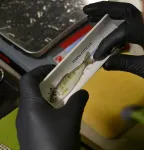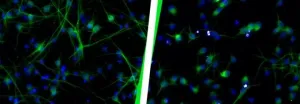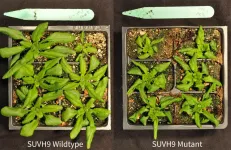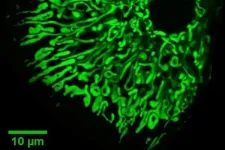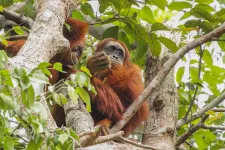(Press-News.org) Juvenile salmon migrating to the sea in the Sacramento River face a gauntlet of hazards in an environment drastically modified by humans, especially with respect to historical patterns of stream flow. Many studies have shown that survival rates of juvenile salmon improve as the amount of water flowing downstream increases, but "more is better" is not a useful guideline for agencies managing competing demands for the available water.
Now fisheries scientists have identified key thresholds in the relationship between stream flow and salmon survival that can serve as actionable targets for managing water resources in the Sacramento River. The new analysis, published May 19 in Ecosphere, revealed nonlinear effects in the flow-survival relationship, meaning it changes in stepwise fashion, with significant jumps in survival rates at two key steps.
A threshold defined in the paper as the "historic mean" flow of 10,712 cubic feet per second (cfs) provides an especially important target for resource managers, said first author Cyril Michel, a project scientist in the Institute of Marine Sciences at UC Santa Cruz.
"We see a substantial increase in salmon survival above that level, so if we can increase stream flow to that level for critical periods of the year, it would really benefit the salmon populations," Michel said.
The researchers analyzed migration survival data from 2,436 juvenile Chinook salmon tagged with acoustic transmitters and tracked in years with different water flows, from 2013 to 2019. After identifying the key thresholds, the team then used historical data on river flows and salmon migration patterns to run simulations of different management actions.
"We wanted to see how much the salmon populations would benefit if we had enacted flows to match that threshold of 10,712 cfs," Michel said. "We found we could increase survival by a lot, sometimes doubling or tripling the survival rates in a given year, without having to spend too much water. It's a reasonable target that won't break the bank in most years."
Juvenile salmon migrate out to sea in the spring, which was historically a period of high flows in the Sacramento River. Now, however, dams and water diversions combined with seasonal reductions in flows from tributaries result in spring flows that tend to be the lowest of the year.
"Because of how we've plumbed the Central Valley, salmon now have to migrate out during low flows. So we're proposing to enact pulse flows in the spring to bring the river up to historical conditions for short periods of time," Michel said.
He noted that plans to implement pulse flows in the Sacramento River are now being developed under environmental permits renegotiated last year for the Central Valley Project, the massive federal water management project that includes the Sacramento River. An interagency group of scientists has agreed to use the 10,712 cfs threshold as the target for these pulse flows, Michel said.
"We're excited that this might actually happen this year or next, and we will be tracking survival rates to see how successful it is," he said. "This could be a tool that is used for many years to come, with real benefits for salmon populations."
Additional research on the optimal timing of pulse flows could improve their implementation, enabling adaptive management in response to environmental conditions, he added.
The study identified two other thresholds, defined as "minimum" (4,259 cfs) and "high" (22,872 cfs). Below the minimum threshold, only 3% of the tagged salmon survived the migration. Survival was 18.9% between minimum and historic mean, 50.8% between historic mean and high, and 35.3% above the high threshold.
The results suggest that the main mechanism behind the flow thresholds relates to how fast migrating fish are able to move through the river and get past the hazards along the way. Travel times for fish during flows between the historic mean and high thresholds were significantly shorter than for fish experiencing all other flows.
"In most years, it's best for juvenile salmon to rear in the upper river where it's safer, and then move through the lower river as quickly as possible to reduce their exposure to predators and other stressors," Michel explained.
INFORMATION:
The research team includes scientists affiliated with both UC Santa Cruz and NOAA's National Marine Fisheries Service (NMFS). The Fisheries Collaborative Program in UCSC's Institute of Marine Sciences supports research collaborations with the NMFS Southwest Fisheries Science Center laboratory in Santa Cruz, located at UCSC's Coastal Science Campus.
In addition to Michel, the coauthors of the paper include Jeremy Notch and Flora Cordoleani at UCSC and Arnold Ammann and Eric Danner at NOAA Fisheries. Funding and resources for the study were provided by the U.S. Bureau of Reclamation, U.S. Fish and Wildlife Service, and the Central Valley Project Improvement Act.
Today, proteins that can be controlled with light are a widely used tool in research to specifically switch certain functions on and off in living organisms. Channelrhodopsins are often used for the technique known as optogenetics: When exposed to light, these proteins open a pore in the cell membrane through which ions can flow in; this is how nerve cells can be activated. A team from the Centre for Protein Diagnostics (PRODI) at Ruhr-Universität Bochum has now used spectroscopy to discover a universal functional mechanism of channelrhodopsins that determines their efficiency as a channel and thus as an optogenetic tool. The researchers led by Professor Klaus ...
Microfluidic technologies have seen great advances over the past few decades in addressing applications such as biochemical analysis, pharmaceutical development, and point-of-care diagnostics. Miniaturization of biochemical operations performed on lab-on-a-chip microfluidic platforms benefit from reduced sample, reagent, and waste volumes, as well as increased parallelization and automation. This allows for more cost-effective operations along with higher throughput and sensitivity for faster and more efficient sample analysis and detection.
Optoelectrowetting (OEW) is a digital optofluidic technology that is based on the principles of light-controlled electrowetting and enables ...
Since our ancestors infected themselves with retroviruses millions of years ago, we have carried elements of these viruses in our genes - known as human endogenous retroviruses, or HERVs for short. These viral elements have lost their ability to replicate and infect during evolution, but are an integral part of our genetic makeup. In fact, humans possess five times more HERVs in non-coding parts than coding genes. So far, strong focus has been devoted to the correlation of HERVs and the onset or progression of diseases. This is why HERV expression has been studied in samples of pathological origin. Although important, these studies ...
Passing down a healthy genome is a critical part of creating viable offspring. But what happens when you have harmful modifications in your genome that you don't want to pass down? Baby plants have evolved a method to wipe the slate clean and reinstall only the modifications that they need to grow and develop. Cold Spring Harbor Laboratory (CSHL) Professor & HHMI Investigator Rob Martienssen and his collaborators, Jean-Sébastien Parent and Institut de Recherche pour le Développement Université de Montpellier scientist Daniel Grimanelli, discovered one of the genes responsible for reinstalling modifications in a baby plant's genome.
A plant's genomic modifications--called epigenetic ...
The study sought to describe and explain gender pay differences in the U.S. Department of Health and Human Services between 2010 and 2018. HHS comprises a quarter of the country's governmental public health workers, with over 80,000 employees.
Understanding what may be driving wage gaps at HHS provides opportunities for employers and legislators to take action to support women in the health care field, said lead author Zhuo "Adam" Chen, an associate professor of health policy and management at UGA's College of Public Health.
"A large percentage of the health care workforce are women," said Chen. "If you have underpaid women in the profession, I don't think it spells good things for the public health system."
Chen ...
Maywood, Ill. - May 19, 2021 - A team of scientists from Loyola University Chicago's Stritch School of Medicine have discovered a critical component for renewing the heart's molecular motor, which breaks down in heart failure.
Approximately 6.2 million Americans have heart failure, an often fatal condition characterized by the heart's inability to pump enough blood and oxygen throughout the body. This discovery could represent a novel approach to repair the heart.
Their findings, published in the May 19 issue of Nature Communications, show how a protein called BAG3 helps replace "worn-out" components of the cardiac sarcomere. The sarcomere is a microscopic ...
FINDINGS
A new multi-institution study led by a team of researchers at the David Geffen School of Medicine demonstrated that blocking a protein called ABCB10 in liver cells protects against high blood sugar and fatty liver disease in obese mice. Furthermore, ABCB10 activity prompted insulin resistance in human liver cells.
The findings are the first to show that ABCB10 transports biliverdin out of the mitochondria - the cell's "energy generating powerhouses." Biliverdin is the precursor of bilirubin, a substance with antioxidant properties. Consequently, ABCB10 transport ...
So, you thought the problem of false information on social media could not be any worse? Allow us to respectfully offer evidence to the contrary.
Not only is misinformation increasing online, but attempting to correct it politely on Twitter can have negative consequences, leading to even less-accurate tweets and more toxicity from the people being corrected, according to a new study co-authored by a group of MIT scholars.
The study was centered around a Twitter field experiment in which a research team offered polite corrections, complete with ...
Orangutans are closely related to humans. And yet, they are much less sociable than other species of great apes. Previous studies have showed that young orangutans mainly acquire their knowledge and skills from their mothers and other conspecifics. Social learning in orangutans occurs through peering, i.e. sustained observation of other members of the species at close range.
An international team led by the University of Zurich (UZH) has now studied peering behavior in young orangutans at two research stations on the islands of Sumatra and Borneo. The data was collected by researchers from the Department of Anthropology of UZH, the Max Planck Institute of Animal Behavior in Constance, the Universitas Nasional in Jakarta and Leipzig University, ...
Do we have free choice or are our decisions predetermined? Is physical reality local, or does what we do here and now have an immediate influence on events elsewhere? The answers to these questions are sought by physicists in the Bell inequalities. It turns out that free choice and local realism can be skilfully measured and compared. The results obtained reveal surprising relationships of a fundamental and universal nature, going far beyond quantum mechanics itself.
Causality, locality, and free choice are related by a few simple formulas known as Bell's inequalities. The sophisticated experiments in quantum optics over the past few decades have unquestionably proved that these inequalities are broken. Today, physicists are ...
